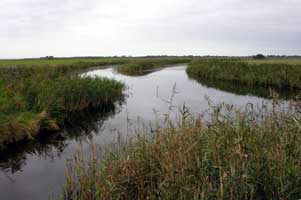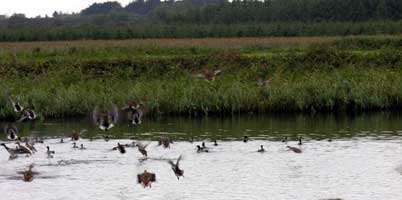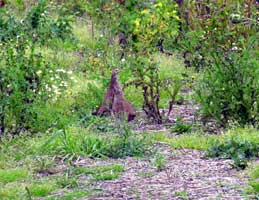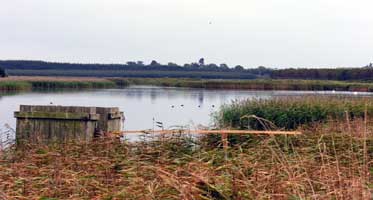
| The South Slob Shoot by Turlough Coffey |
The Wexford Slobs, south and north were reclaimed by an Act of Parliament passed in 1846, and the South Slob project was taken on by the Redmond family, a renowned Wexford family who later recruited many Irish nationalists to fight for “the freedom of small nations” in the first world war, known as “Redmondites”. An earlier attempt to reclaim land from Wexford Harbour thirty years earlier had failed. This sea bank wall was built by the Thomas brothers from Weston Super Mare in England. The remnants of the bank can still be seen at low tide and the writer lived the Thomas brother’s house “Weston” in Wexford until February 2005.
 The reputation of Wexford Harbour as a first class wild fowling area pre-dates the reclaiming of the slobs. Sir Ralph Payne-Gallwey’s book “The Fowler in Ireland” tells of the great flocks of brent geese and widgeon in the harbour. The 1798 ballad “Kelly the Boy from Killane” tells of his long-barrelled gun of the sea” a reference to a wildfowling piece which found a new purpose in the rebellion. Even in living memory many families in Wexford made a living from the harbour, fishing in summer and fowling in winter, the punt gun and +float being the most favoured equipment for the latter. In Wexford the brent goose (pale bellied) was called the bernicle, which caused much confusion with the barnacle, the widgeon which were called “whinnard”, and waders were all called “graineog”. The wildfowling proved to be a great asset once the slobs were reclaimed and the shooting was carefully guarded by the new landowners. The number of guns was limited, a period between shoots was observed, and a gamekeeper employed to deal with vermin and poachers. The term we would use now is “properly managed”. We have inherited this enlightened regime and our wildfowling is for one morning fortnightly during the season. We release 6,000 mallard, we have bag limits early in the season, we use experienced guides with good dogs to look after the guns and to retrieve shot birds. As many readers will know zostera (eel grass or “woor” was the Wexford name) was the main diet of brent geese and widgeon until the 1930’s when disease struck and zostera was almost wiped out throughout Europe. The brent and widgeon largely changed their diet to grass and widgeon are now found inland in winter in big numbers, which is our loss on the slobs.  However, in addition to mallard we get a good mixed bag with teal, widgeon, tufted scaup, pochard, goldeneye, gladwell, shoveler, snipe and golden plover featuring in the bag. We have twelve wildfowl shoots in the year, most of our members are full guns but we have some vacancies throughout the season for visiting guns. We are affiliated to the National Association of Regional Game Councils which has 25,000 members and to Wexford Regional Game Council. In fact the writer is The Game Development Officer for the National Association of Regional Game Councils and Honorary Secretary of Wexford Regional Game Council. About 16 years ago Wexford Regional Game Council started a grey partridge project locally as we had a small remnant population of wild birds in the county. Although there was no history of partridge on the slobs and we know that the birds hate mud and wet areas we released partridge and they did breed successfully for three years after release, and then they vanished.  This year I have taken over the shooting on the South Slob and in addition to the wildfowling I have started a game shoot. Although we have flat terrain we have mixed forestry planted from 10 to 20 years ago and this gives us holding cover and suitable driving areas. This year we have planted 400 acres of game crops in eight plots throughout the farm. We have released 1,000 partridge a mixture of greys and redleg by using the Game Conservancy recommended method of release, with one important modification thanks to Albert Titterington the esteemed publisher of this magazine, a return gate, and these pens are a major success. We broke another Game Conservancy rule by mixing greys and redlegs in the same pen and this has also worked. The whole process of driving partridge is a difficult art but we are learning fast and we have a great team of beaters led by the wildfowling guides on the slobs whom I can’t praise highly enough. I have also released 1,000 pheasants in two large release pens in the woods and these are being fed into the game crops. The pheasants are presenting very well over the guns in the partridge drives so all looks well for the season ahead (opens 1st. November in Republic).  As a start to the year I brought in hens from two driven shoots and released them in spring and we had enough “wild” cocks on the ground. I fed the pheasants in the spring and we have a very good production of wild birds. Of course I also had a very active vermin control programme from February to July in particular. I start with rats, a much neglected problem for game and duck rearers, as I believe they are our biggest predator on eggs and young birds. Then the winged vermin, and with five larsen traps I took over 400 magpies and greycrows this year and for the first time I frequently caught grey crows with magpie call birds. On foxes we lamped, dug out and shot them using hounds to beat them from cover. For mink we keep the traps going particularly at bridges and culverts. I sincerely want to thank Albert Titterington for his interest and advice, on the last occasion we released partridges without the return gate we lost a lot of birds to sparrowhawks and hen harriers in particular, the return gate seems to have solved that problem. The Wexford Slobs are renowned for the wintering population of geese, Payne-Gallwey tells us in the 1880’s there were bean geese, by the first world war there were greyleg geese and by the end of the second world war there were Greenland whitefronted geese. The goose shooting was second to none and the regime ensured that the shooting was sustainable, however a moratorium was introduced in 1984 after which we got two short seasons although the whitefront population in Wexford increased from 6,000 to 10,000 in the 1980’s. In Iceland they are shooting 3,000 a year in spite of the Wexford agreement of 1992 which was supposed to guarantee equal and wise use of the natural resource. The wildfowlers of Ireland were badly betrayed by that “so called agreement”. The game shoot this season will be run by selling gun days to guest guns as I do not intend to form a syndicate at this stage, from 1st. November we will be shooting pheasants and partridge. +THE PUNT IS CALLED A FLOAT IN WEXFORD Editors Note: I was delighted to take up Turlough’s invitation to visit the shoot in late September. It really is a magical place and very obviously well managed with a healthy mix of planned and natural environment. Plantations of conifers and plots of game cover add to the variety of a landscape largely made up of rich reclaimed land and reed framed canals opening out into the seascape of Wexford Bay -so beloved of fowlers of yesteryear such as Sir Ralph Payne-Gallwey,Bart. Apart from the mass of reared and wild ducks, there was a good show of rapidly acclimatising partridge and young and mature wild and reared pheasant. There also appeared to be a lack of vermin that again demonstrated the good management of this shoot. Some days are available so if you want to shoot this fantastic place call : Turlough on 00353 54 47789 / Fax : 00535 5447055 for details. Also If you want the ideal dog for wildfowling Turlough tells me he often has some working bred Irish Water Spaniel pups for sale – same number as above. I hope to visit the shoot in January when it is in full operation and when the geese are in – although these cannot be shot, “ poor would he be of soul” not to want to see skeins of geese on the slobs. |